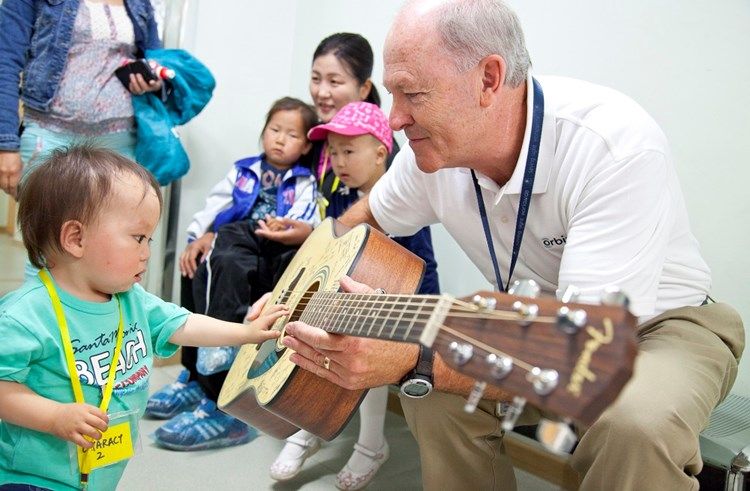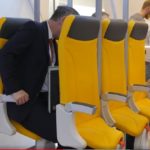FINN caught up with Director of aircraft operations and maintenance at Orbis, Bruce Johnson and the Flying Eye Hospital’s Chief Pilot, Captain Gary Dyson, on World Sight Day to find out more about how the charity has developed and take a look forward to the aircraft’s visit during FIA 2020
The Flying Eye Hospital is a hospital with a difference.
Instead of patients with avoidable blindness going to hospital, the hospital is taken to them. The aircraft is used as a teaching hospital as well as treating patients with avoidable blindness. In the past year, the specially fitted MD10 has taken its sight saving mission across the globe and will soon be departing on its next stop: Ghana.
Orbis leaves the countries it visits with an actionable skills programme, with skills followed up year-on-year to ensure continued development using an online programme called Cybersight, run with the assistance of doctors and consultants all over the world.
The current aircraft, which has been in use since 2016, is the third generation flying eye hospital. The charity previously used a DC8, followed by DC10 in 1994. In the previous generation aircraft, the hospital was part of the aircraft itself and had to be certified with the aircraft. Within the MD10, the hospital is configured in containers and the hospital is loaded as modular pods and its therefore treated as freight. With no connection to the aircraft, the hospital aspect only needs to be certified as a hospital and not certified as part of the aircraft, meaning a significant reduction in costs.
Orbis has a crew of 17 volunteer pilots who each commit 25 days per year to the charity’s activities, which include flying or receiving training. Gary Dyson has been an Orbis pilot for 19 years and still a full time pilot for Fed-Ex.
For anyone who hasn’t heard of Orbis before can you, in a nutshell, describe what it is that you do?
BJ: “Orbis is an international, non-profit organisation that treats and prevents avoidable blindness and visual impairment in the world. The big nutshell part is we do it slightly different where a lot of non-profits do it through a service, we do it through training so we work with the local healtcare professionals and the universities, hospitals , government agencies and we set up the training events and exchange the skills and experience, so eventually they can stand on their own and do it themselves.”
How does flying with Orbis differ from flying on a regular aircraft and can you describe a typical day?
GD: “When you work for an airline whether it be a cargo airline or a passengers. A ‘regular’ pilot would turn up to work and someone has already prepared the flight plan for them and carried out the pre-flight checks. As a volunteer pilot for Orbis you have to go back to all the skills you learned as a young pilot and do a lot of it on your own.”
“One of the big differences is going to locations you would not normally go to as a pilot or passenger. Instead of saying ‘a day in the life,’ you really have to say a ‘week in the life of an Orbis pilot’ because you have to get a flight out to the location of the aircraft – it could take two days just to get to where the aircraft is.”
“Two days prior to departure of the trip, we will carry out full system check – as it has normally been stationary and used as a hospital for two to three weeks, so we have to see that everything that hasn’t been used and that its still working, normally it is but it is just our due diligence to check the systems out the day before. Then we show up on fly day and fly the aircraft to where it is needed, As a pilot, that is our contribution.”
“As a volunteer you feel much more part of the team if you stay around for a few days and help out, doing something rather than just the fly the airplane. The initial draw was the fact that we get to flew this really cool, one of a kind, piece of aviation medical technology.”
“Once you see a child who is blind on Monday but can see on Wednesday, then it becomes much more than just flying the airplane. It is something you want to do again and again. No one quits as a volunteer pilot, we have to kick them out of the door.”

We met you back in Dubai in 2017 and gained an insight into the amazing work you do. How have things developed since we last saw you?
BJ: “We have continued our fight against avoidable blindness across the world and tried to improve and increase what we do each and every year.”
“In 2018, we funded 63 programmes in 27 countries; we undertook screenings of 3 million children; during that timeframe, we did 78,000 surgeries and laser treatments; and we did some 63,000 training events with doctors, nurses and the healthcare community in 2018 alone. It was a pretty successful year.”
“Orbis is much more than just the airplane. Years ago, in 1982, Orbis was basically the airplane. Over the years, we have 15 country offices now and the majority of the work is actually done outside of the airplane – its 30 per cent of our work.”
“We have a web based system called Cybersight – where have access to the internet to do educational training and seminars. We can even do remote clinical sessions on the internet now as remote education. We also have hospital-based training events, of which these are a great deal of our total number, where we sent some of our staff out to our partner hospitals for events.”
“Our simulation programme allows us to embed issues into synthetic eyes which cuts down on screening and training time. In the past, many countries had no avenue to train but the patients themselves.”
“We have just launched the first complete simulation programme, where we did no surgery on live patients. When you look at training, to reduce that footprint, machines are the thing of the future. Much like aviation. Why practice on a human when you can eliminate many of the errors or stress? We used simulation on airplanes a long time ago.”
Orbis is the Official Charity Partner of FIA 2020 and the aircraft will be coming to the show in July– why is attending a show like FIA important to an organisation like Orbis?
GD: “We’ve been around since 1982 but people say we haven’t heard of you. We are not known by a lot of people so we are always looking for long term support. So to get out brand out there and let everyone see the airplane, that’s why we come to events like this. This will be the most prestigious place we have ever had the airplane, I believe.”
BJ: “One of the reasons why nobody knows us. When we talk about those millions of numbers where people are blind or visually impaired, 89 per cent of those people are in low income countries, that’s where we do our work. Places like England and the United States, people don’t need us and we don’t spend our time there. Our greatest impact is where the greatest need is.”
“For people interested in aviation, our airplane will be a good draw because it is a plane that was repurposed to do something other than haul a passenger or haul freight. You will see some real one off things inside, the airplane and the hospital are apart from each other. They are also two pretty dynamic industries, aviation and medicine, we put those together and you can see how that’s done.
“There’s a lot of really neat technology in it – from the 3D, the AI, the data link and all the surgeries we do live. The technologies, the use of the plane, the though process out of the box thinking.”
Today is World Sight Day – why is a day like this vital in raising awareness for a charity like Orbis? What messages / activities as an organisation are you focusing on?
BJ: “By 2050 they expect blindness is going to triple, but the good news is that 75 per cent is full treatable or curable in some way.
“People are living longer – that’s part of the reason why blindness increases. The longer you live the more prone you are to cataracts which is the leading cause of blindness across the world.”
GD: “Most of the countries are developing countries where they have limited resources. If you send doctors and nurses to a hospital there, that gets some attention from the Minister of Health. But if you fly this airplane in there, you get the attention of the leaders of the country and maybe you can raise their awareness of their own issues in their country and maybe encourage them to spend a little more of their resources treating blindness.”
BJ: “There are some statistics that show that every dollar spent on eyecare or healthcare, it gives $4 in return. In some of these countries, if you take a blind person out of the economic growth of the country, it also removes another individual to take care of them. So you get two people out. If you can cure the blindness, you get two people back into the workforce.
“It is a big impact not only education wise, but economically as well. It has a big impact saving someone’s sight.”

